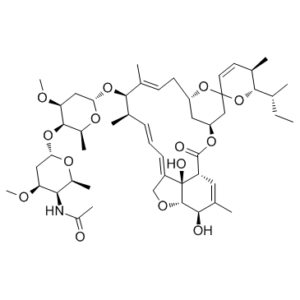Eprinomectin (also known as MK-397) is an avermectin used as a veterinary topical endectocide with anthelmintic, insecticidal and miticidal activity. It is a mixture of two chemical compounds, eprinomectin B1a and B1b. It is a semi-synthetic GABA signaling potentiator used to inhibit bacterial infections and can cause neuromuscular paralysis in microbes and parasites.
Physicochemical Properties
| Molecular Formula | C50H75NO14;C49H73NO14 |
| Molecular Weight | 914.13 |
| CAS # | 123997-26-2 |
| Related CAS # | Eprinomectin-d3 |
| Appearance | White to off-white solid powder |
| Density | 1.23 |
| Melting Point | 163-166 ºC |
| Flash Point | 2 °C |
| LogP | 5.469 |
| SMILES | C[C@H]1[C@@H](NC(C)=O)[C@@H](OC)C[C@H](O[C@@H]2[C@H](C)O[C@@H](O[C@@H](/C(C)=C/C[C@@H](C3)OC4(O[C@@H]([C@@H](CC)C)[C@H](C)C=C4)C[C@H]3OC5=O)[C@@H](/C=C/C=C6CO[C@@H]7[C@@]\6(O)[C@H]5C=C(C)[C@H]7O)C)C[C@@H]2OC)O1 |
| InChi Key | WPNHOHPRXXCPRA-TVXIRPTOSA-N |
| InChi Code | InChI=1S/C49H73NO14/c1-25(2)43-28(5)17-18-48(64-43)23-35-20-34(63-48)16-15-27(4)44(26(3)13-12-14-33-24-57-46-42(52)29(6)19-36(47(53)60-35)49(33,46)54)61-40-22-38(56-11)45(31(8)59-40)62-39-21-37(55-10)41(30(7)58-39)50-32(9)51/h12-15,17-19,25-26,28,30-31,34-46,52,54H,16,20-24H2,1-11H3,(H,50,51)/b13-12-,27-15-,33-14-/t26-,28-,30-,31-,34+,35-,36-,37+,38-,39-,40-,41+,42+,43+,44-,45+,46+,48+,49+/m0/s1 |
| Chemical Name | Avermectin B1, 4''-(acetylamino)-4''-deoxy-, (4''R)- |
| Synonyms | MK 397; MK-397; MK397; Eprinex; 4'-epi-acetylamino-4'-deoxy-avermectin B1a |
| HS Tariff Code | 2934.99.9001 |
| Storage |
Powder-20°C 3 years 4°C 2 years In solvent -80°C 6 months -20°C 1 month |
| Shipping Condition | Room temperature (This product is stable at ambient temperature for a few days during ordinary shipping and time spent in Customs) |
Biological Activity
| ln Vitro |
Eprinomectin (2.5-50 μM; 0-48 h) significantly inhibits DU145 cell viability (IC50: 12.5 μM), colony formation and migration ability, and induces G0/G1 phase cell cycle arrest [1]. Eprinomectin (10-50 μM; 48 h) induces apoptosis and autophagy, increases reactive oxygen species production and endoplasmic reticulum stress, and promotes β-catenin nucleocytoplasmic translocation in DU145 cells [1]. |
| ln Vivo | Eprinomectin (0.08-0.5 mg/kg; Local pipette delivery; 14 days) has insecticidal, insecticidal and acaricidal activities in cattle[2]. Pharmacokinetic Analysis in cattle[1] |
| Cell Assay |
Cell Viability Assay[1] Cell Line: DU145 cells Concentration: 2.5, 5, 10, 25 and 50 μM Incubation Time: 48 h Result: Significantly inhibited the cell viability. Western Blot Analysis[1] Cell Line: DU145 cells Concentration: 10, 25 and 50 μM Incubation Time: 48 h Result: Promotes the protein expression of pro-apoptotic marker BAD and DNA damage marker pH2AX and caspase-9 in a concentration-dependent manner. Inhibits DNA repair by reducing PARP-1. |
| Animal Protocol |
Animal Model: Infective nematode or chorioptes bovis treated male Jersey calves[2] Dosage: 0.08, 0.16, 0.2, 0.24 and 0.5mg/kg Administration: Delivered topically from the tailhead to the withers at skin level via a pipette; 14 days Result:At the lowest dose (0.08 mg/kg), maximal or near-maximal efficacy was achieved against most adult endoparasites, with the exception of Capillaria serpiginosa (87%) and Capillaria cysticercus (88%). Control was ≥ 95% at all dose levels at day 14 post-treatment and was maintained at or near this efficacy level over the 6-week trial period. |
| References |
[1]. Eprinomectin: a derivative of ivermectin suppresses growth and metastatic phenotypes of prostate cancer cells by targeting the β-catenin signaling pathway. J Cancer Res Clin Oncol. 2023 Sep;149(11):9085-9104. [2]. Eprinomectin: a novel avermectin for use as a topical endectocide for cattle. Int J Parasitol. 1996 Nov;26(11):1237-42. [3]. Injectable eprinomectin for cattle: Tick efficacy and pharmacokinetics. J Vet Pharmacol Ther. 2020 Mar;43(2):171-178. |
Solubility Data
| Solubility (In Vitro) |
DMSO : 100~125 mg/mL (~136.74 ) Ethanol :~ 100 mg/mL |
| Solubility (In Vivo) |
Solubility in Formulation 1: ≥ 2.5 mg/mL (2.73 mM) (saturation unknown) in 10% DMSO + 40% PEG300 + 5% Tween80 + 45% Saline (add these co-solvents sequentially from left to right, and one by one), clear solution. For example, if 1 mL of working solution is to be prepared, you can add 100 μL of 25.0 mg/mL clear DMSO stock solution to 400 μL PEG300 and mix evenly; then add 50 μL Tween-80 to the above solution and mix evenly; then add 450 μL normal saline to adjust the volume to 1 mL. Preparation of saline: Dissolve 0.9 g of sodium chloride in 100 mL ddH₂ O to obtain a clear solution. Solubility in Formulation 2: 2.5 mg/mL (2.73 mM) in 10% DMSO + 90% (20% SBE-β-CD in Saline) (add these co-solvents sequentially from left to right, and one by one), suspension solution; with ultrasonication. For example, if 1 mL of working solution is to be prepared, you can add 100 μL of 25.0 mg/mL clear DMSO stock solution to 900 μL of 20% SBE-β-CD physiological saline solution and mix evenly. Preparation of 20% SBE-β-CD in Saline (4°C,1 week): Dissolve 2 g SBE-β-CD in 10 mL saline to obtain a clear solution. Solubility in Formulation 3: ≥ 2.5 mg/mL (2.73 mM) (saturation unknown) in 10% DMSO + 90% Corn Oil (add these co-solvents sequentially from left to right, and one by one), clear solution. For example, if 1 mL of working solution is to be prepared, you can add 100 μL of 25.0 mg/mL clear DMSO stock solution to 900 μL of corn oil and mix evenly.. Solubility in Formulation 4: 10% DMSO+40% PEG300+5% Tween-80+45% Saline: ≥ 2.5 mg/mL (2.73 mM) (Please use freshly prepared in vivo formulations for optimal results.) |
| Preparing Stock Solutions | 1 mg | 5 mg | 10 mg | |
| 1 mM | 1.0939 mL | 5.4697 mL | 10.9394 mL | |
| 5 mM | 0.2188 mL | 1.0939 mL | 2.1879 mL | |
| 10 mM | 0.1094 mL | 0.5470 mL | 1.0939 mL |
